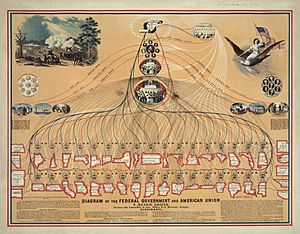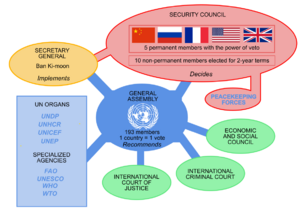Organization facts for kids
An organization is a group of people who work together for a special reason. Think of a school, a sports team, or a company. They all have a goal they want to achieve.
Organizations can be big or small. They can be formal, like a government office, or more informal, like a local club. Some organizations are recognized by the government, often by filling out special paperwork. Others might be recognized because they help a community or speak for a group of people.
The word "organization" comes from an old Greek word, organon, which means "tool" or "instrument." This makes sense because an organization is like a tool that helps people work together to get things done.
Contents
Different Kinds of Organizations
There are many different types of organizations in the world. Here are some common ones:
- Companies: These are businesses that make products or offer services to earn money.
- Governments: These groups manage countries, states, or cities.
- Non-governmental organizations (NGOs): These are groups that work for social or environmental causes, like helping people in need or protecting nature.
- International organizations: These groups work across different countries, like the United Nations.
- Charities: These organizations help people or causes, often relying on donations.
- Schools and universities: These are places where people learn.
- Clubs and associations: These are groups of volunteers who share a common interest or goal.
Some organizations are called hybrid organizations because they work in both the public (like government) and private (like business) areas at the same time.
How Organizations Are Set Up

The way an organization is set up is called its organizational structure. This structure helps everyone know their role and how to work together. Here are some common ways organizations are structured:
Teams or Committees
Sometimes, a group of people works together as a team or committee to make decisions. They might vote on ideas. For example, a jury in a court makes decisions together. A school committee might decide on new rules for students. The main idea is that a group of peers makes choices together.
Flexible Structures
Some organizations are set up to encourage friendly competition among their different parts. This means that parts of the organization that do well get more resources, while less effective parts might need to improve. This can help the organization stay strong and efficient.
Matrix Structures
In a matrix organization, a worker might have two different bosses. One boss might be in charge of their specific skill, like engineering. The other boss might be in charge of a specific project they are working on. This helps make sure that projects get done while also keeping experts well-trained in their fields. This type of structure was first used in the United States aerospace industry in the 1960s.
Pyramid or Hierarchy Structures

Many organizations are set up like a pyramid, with a leader at the top and different levels of people below them. This is called a hierarchy. In this structure, people at higher levels usually have more authority and make more important decisions. For example, a school principal is at the top, with teachers and staff below them. For this structure to work well, the leader needs the support of the people working below them.
How People Think About Organizations
Experts from different fields study organizations to understand how they work.
- How they are used: Some people look at how organizations like businesses or government offices are used to achieve goals.
- Their purpose: Others see an organization as a group with a specific purpose within a larger community.
- Their actions: Some focus on how organizations are always changing and reorganizing themselves to get tasks done.
Organizations help people work together to achieve things that one person couldn't do alone. When people join an organization, they might give up some personal freedom, but they gain the ability to do more and combine different skills.
Leadership in Organizations
In a formal organization, a leader is usually someone appointed to a management position. They have the right to give commands because of their job title. However, a good leader also needs personal skills to inspire and guide others. If a manager doesn't have strong personal skills, someone else might emerge as an unofficial leader.
Formal Organizations
A formal organization is set up with clear rules and goals. It has a specific structure with departments, jobs, and tasks. Everyone knows their role. For example, a large company has clear job descriptions and rules for how employees should work. People are usually hired and promoted based on their skills or how long they've worked there.
Informal Organizations
An informal organization is different. It's made up of the personal goals and relationships among people within the formal structure. Think of the friendships and unofficial groups that form at school or work. These groups happen naturally because people like to connect with others.
In informal groups, leaders often emerge because of their personality, skills, or how they handle situations. These leaders might not have a fancy job title, but they have influence. Influence means they can get others to cooperate through persuasion. Power is a stronger form of influence, where they can make things happen, sometimes by controlling rewards or punishments.
How Formal and Informal Groups Work Together
Most organizations use a mix of formal rules and informal relationships. Sometimes, formal rules can help build trust and good relationships among people. Other times, strong informal relationships can make formal rules less necessary. Understanding how these two parts work together is key to a successful organization.
See also
 In Spanish: Organización para niños
In Spanish: Organización para niños
- Affinity group
- Anticipatory socialization
- Business organization
- Coalition
- Collective
- Decentralized autonomous organization
- History of organizations
- List of designated terrorist organizations
- List of environmental organizations
- List of general fraternities
- List of international professional associations
- List of trade unions
- Maturity model
- Multidimensional organization
- Mutual organization
- Organizational psychology
- Organization Workshop
- Pacifist organization
- Requisite organization
- Service club
- Size of groups, organizations, and communities
- Umbrella organization
- Voluntary association

